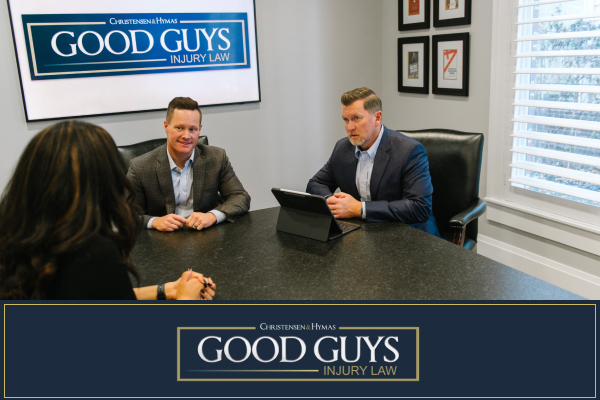
If you are injured in an accident, you may be entitled to compensatory damages. These damages fall into two main categories: economic damages and non-economic damages. Understanding the difference can help you seek compensation for your losses.
Good Guys Injury Law helps accident victims recover fair monetary compensation. Personal injury cases often include costs like medical expenses, lost wages, and property damage. These are considered economic damages because they involve quantifiable financial losses. But injuries affect more than just money. Pain, suffering, and emotional distress also matter. These are non-economic damages and can impact your quality of life.
Knowing how these damages work can help you build a strong personal injury claim. Whether dealing with medical bills, lost income, or long-term suffering, understanding your rights is key.
Table of Contents
What Are Economic Damages?
Economic damages are tangible financial losses caused by an accident or injury. These losses have a clear dollar value and can be proven with bills, receipts, and financial records. Personal injury cases often include these damages to help victims recover the money they lost.
If you suffer injuries, you may incur medical costs, lose income, or suffer property damage. These costs add up quickly and can create serious financial stress. Economic damages help you recover compensation for these losses.
Unlike non-economic damages, which are harder to measure, economic damages are based on real expenses. A lawyer can help calculate the total amount by adding up past bills and estimating future medical expenses or lost income.
Common Types of Economic Damages

- Medical Expenses – Covers medical treatment, hospital stays, doctor visits, surgeries, medications, and physical therapy.
- Lost Wages – Compensates for income lost while recovering from suffered injuries.
- Future Earnings – Covers the loss of future income if the injury affects your ability to work.
- Property Damage – Pays for repairs or replacement of damaged property, such as a car in an accident.
- Rehabilitation Costs – Includes rehabilitation costs for long-term recovery, such as therapy or in-home care.
- Financial Losses Incurred – Any other financial losses related to the accident, including transportation costs for medical visits.
How Economic Damages Are Calculated
Economic damages are based on actual costs. They include quantifiable financial losses, making them easier to prove in a personal injury lawsuit. The total amount is calculated by adding past expenses and estimating future costs.
For example, medical expenses include not only past hospital bills but also future medical expenses if more treatment is needed. Lost wages cover time missed from work, while future earnings account for long-term income loss.
In personal injury cases, experts may be brought in to assess the financial impact. Medical professionals can estimate rehabilitation costs, and economists can determine lost income potential. A lawyer can gather the necessary proof to ensure all financial losses incurred are included in the claim.
What Are Non-Economic Damages?
Non-economic damages compensate for losses that do not have a direct financial cost. These damages focus on the emotional and personal impact of an injury. Unlike economic damages, which cover medical expenses and lost wages, non-economic damages address pain, suffering, and loss of enjoyment of life.
Serious injuries can affect mental health, relationships, and daily activities. Emotional distress, post-traumatic stress disorder, and chronic pain are common examples. These losses do not come with bills or receipts, but they still have a major impact.
Courts award non-economic damages to recognize these hardships. The amount depends on the severity of the injury and how it affects a person’s life. A skilled lawyer can help prove the extent of intangible losses in a personal injury claim.
Common Types of Non-Economic Damages

- Pain and Suffering – Compensation for physical pain caused by an injury.
- Emotional Distress – Covers mental health struggles like anxiety, depression, or post-traumatic stress disorder.
- Loss of Enjoyment of Life – Applies if an injury prevents a person from enjoying hobbies or daily activities.
- Loss of Consortium – Compensation for how an injury affects relationships with a spouse or family.
- Disfigurement or Disability – Covers the emotional toll of permanent scars, amputations, or disabilities.
- Sexual Gratification Issues – Compensation for loss of intimacy or sexual function due to injuries.
- Intangible Losses – Any other personal suffering that does not have a direct financial value.
How Non-Economic Damages Are Calculated
Unlike economic damages, which have clear costs, non-economic damages are more difficult to measure. Since there are no bills for pain and suffering, courts use different methods to determine a fair amount.
One common approach is the multiplier method. This means multiplying the total economic damages by a certain number based on injury severity. For example, if medical bills and lost wages total $50,000, and the multiplier is three, the non-economic damages would be $150,000.
Another method is the per diem approach, which assigns a daily rate for pain and suffering. The longer the recovery, the higher the total non-economic damages. An experienced personal injury attorney can help argue for the highest possible compensation.
Differences Between Economic and Non-Economic Damages

Both economic damages and non-economic damages compensate injury victims. The difference is how they are measured. Economic damages cover quantifiable financial losses, like medical expenses and lost wages. Non-economic damages focus on intangible losses, like emotional distress and pain.
Here are the key differences between these two types of compensatory damages:
Objective vs. Subjective Compensation
Economic damages are based on actual costs. They are easy to prove with receipts, pay stubs, and financial records. For example, medical treatment, property damage, and rehabilitation costs all have clear values.
Non-economic damages, however, are more subjective. Pain and suffering do not have a set price. Instead, courts look at how an injury affects a person’s daily life. Someone with post-traumatic stress disorder or chronic pain may receive higher compensation. Since these damages are harder to measure, an experienced personal injury attorney is often needed to prove their value.
Impact on Settlement Amounts
The amount of compensatory damages awarded depends on many factors. Economic damages are straightforward since they are based on tangible financial losses. The more severe the injury, the higher the medical expenses, which increases compensation.
Non-economic damages vary widely. Courts consider factors like emotional suffering, permanent disability, and how the injury impacts relationships. If an injury leads to lifelong pain or prevents someone from working, non-economic damages may be much higher than economic damages.
In some cases, punitive damages are also awarded. These are extra payments meant to punish reckless behavior. While they are not common in every personal injury lawsuit, they can significantly increase the final settlement.
State Laws and Damage Caps
Some states limit how much a person can receive for non-economic damages. These limits are called damage caps. While economic damages are usually not restricted, states may put a maximum on pain and suffering compensation.
For example, medical malpractice cases in some states have strict limits on non-economic damages. This means even if someone experiences severe emotional distress, their compensation may be capped. An experienced personal injury attorney can help determine how state laws affect a case.
Understanding these limits is important when filing a personal injury claim. If a state has damage caps, it may impact the total settlement amount.
How a Lawyer Can Help Maximize Compensation
Filing a personal injury claim can be confusing. A lawyer can help gather proof, talk to the insurance company, and fight for fair payment. Without legal help, you may not get all the money you deserve.
An experienced personal injury attorney makes sure all damages are included. This means adding up medical expenses, lost income, and property damage. They also help prove non-economic damages, like emotional distress or pain.
Here are key ways a lawyer can help:
Proving Economic Damages
To get fair payment, you need to prove how much money you lost. A lawyer collects records like:
- Medical bills – Shows the cost of medical treatment, therapy, and medicine.
- Pay stubs and tax returns – Proves how much money was lost from missing work.
- Receipts for repairs – Covers property damage like fixing a car after an accident.
A lawyer also helps estimate future costs. If you need physical therapy, surgery, or long-term care, these future costs should be included. Some injuries prevent people from working again. If this happens, a lawyer calculates future earnings to make sure nothing is left out.
Demonstrating Non-Economic Damages
Proving non-economic damages is harder because there are no receipts for pain or stress. A lawyer uses different methods to show the impact of an injury.
- Medical records – A doctor’s notes help prove emotional distress, pain, or post-traumatic stress disorder.
- Journals or personal statements – Writing about pain, fear, or lost happiness can be strong evidence.
- Testimony from friends or family – People close to the victim can explain how life has changed since the accident.
Lawyers also work with experts. A doctor or therapist can explain how the injury causes emotional distress. This helps the court understand why non-economic damages should be paid.
Negotiating with Insurance Companies
Insurance companies try to pay as little as possible. They may argue that injuries are not serious or that medical costs are too high. A lawyer knows how to handle these arguments and fight for a fair deal.
A lawyer gathers strong proof to show the real cost of economic damages and non-economic damages. If the insurance company refuses to pay enough, the lawyer can take the case to court. Many people who hire a lawyer get higher payments than those who handle their claims alone.
Having an experienced personal injury attorney increases the chances of getting full compensatory damages. A lawyer knows the law, understands insurance company tactics, and fights to seek compensation for every loss.
FAQs
1. What is the difference between economic and non-economic damages?
Economic damages cover tangible financial losses, like medical expenses, lost wages, and property damage. These have exact dollar amounts. Non-economic damages cover pain, emotional distress, and other intangible losses that do not have a clear cost.
2. How do I prove non-economic damages?
Since there are no receipts for pain or stress, proof comes from medical records, therapy notes, and personal journals. Friends, family, and doctors can also explain how the injury affected daily life. A lawyer can help gather strong evidence.
3. Are there limits on how much I can get for non-economic damages?
Some states have damage caps that limit non-economic damages in certain cases, like medical malpractice cases. Economic damages usually have no limits. A lawyer can check if these laws apply to your case.
4. Can I still get compensation if I was partly at fault?
Yes, but the amount may be reduced. Some states use “comparative fault” rules, meaning you can still seek compensation even if you were partially responsible. A lawyer can explain how this affects your case.
5. Why do I need a lawyer for my personal injury claim?
A lawyer helps prove losses, deal with the insurance company, and fight for fair payment. They make sure economic damages and non-economic damages are fully counted. Without legal help, you may not get the full amount you deserve.
Contact Our Experienced Injury Lawyers Today

If you or a loved one suffered injuries, you may be entitled to compensatory damages. You should not have to handle medical bills, lost income, and pain alone.
Good Guys Injury Law fights to get accident victims the full monetary compensation they deserve. Our experienced personal injury attorneys understand the law and know how to deal with the insurance company. We will work to prove your economic damages and non-economic damages so you get a fair settlement.
Do not wait to seek compensation. Contact us today for a free consultation. We will review your case and explain how we can help. Let us fight for your rights while you focus on recovery.
